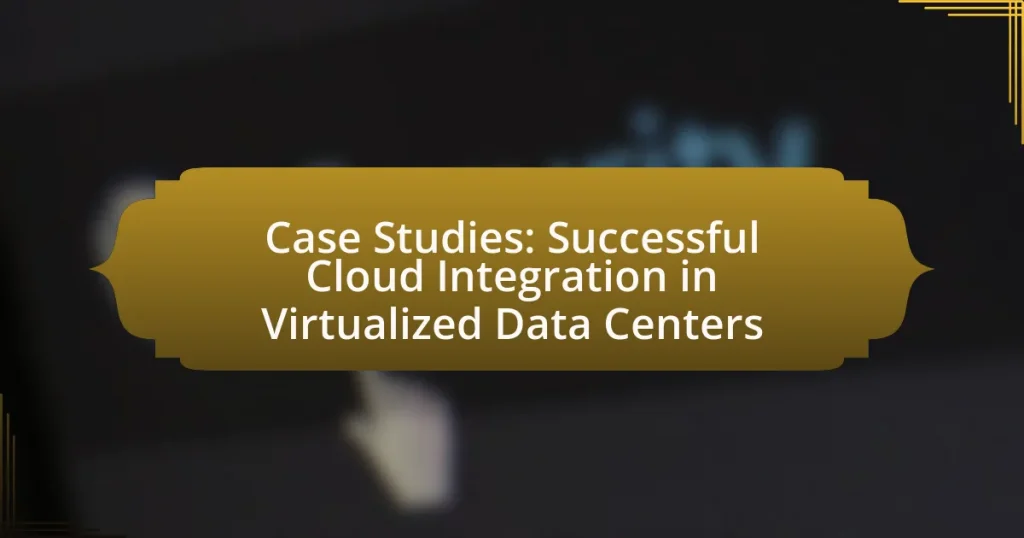The article focuses on case studies that illustrate successful cloud integration in virtualized data centers, highlighting the strategies organizations employ to overcome challenges and achieve measurable outcomes. It discusses the importance of cloud integration for enhancing scalability, cost efficiency, and performance, while also outlining the criteria that define successful case studies. Key components of effective cloud integration, essential technologies, and best practices are examined, along with notable examples from various industries. The article emphasizes the lessons learned from these case studies, including the significance of strategic planning, robust security measures, and ongoing support post-integration for sustained success.
What are Case Studies in Cloud Integration for Virtualized Data Centers?

Case studies in cloud integration for virtualized data centers are detailed analyses that showcase how organizations successfully implement cloud solutions within their virtualized environments. These case studies typically highlight specific challenges faced by the organizations, the cloud integration strategies employed, and the outcomes achieved, such as improved scalability, cost efficiency, and enhanced performance. For instance, a case study might detail how a financial institution migrated its legacy systems to a hybrid cloud model, resulting in a 30% reduction in operational costs and a 50% increase in system availability. Such documented experiences provide valuable insights and best practices for other organizations looking to undertake similar cloud integration efforts.
How do case studies illustrate successful cloud integration?
Case studies illustrate successful cloud integration by providing real-world examples of organizations that have effectively transitioned to cloud-based solutions, demonstrating measurable improvements in efficiency, scalability, and cost savings. For instance, a case study of a financial services company showed a 30% reduction in operational costs after migrating to a cloud infrastructure, highlighting the financial benefits of cloud integration. Additionally, a healthcare provider’s case study revealed enhanced data accessibility and collaboration among departments, leading to a 25% increase in patient care efficiency. These examples validate the effectiveness of cloud integration by showcasing specific metrics and outcomes that organizations have achieved through their cloud adoption strategies.
What criteria define a successful cloud integration case study?
A successful cloud integration case study is defined by clear objectives, measurable outcomes, stakeholder satisfaction, and scalability. Clear objectives ensure that the integration aligns with business goals, while measurable outcomes provide quantifiable evidence of success, such as improved performance metrics or cost savings. Stakeholder satisfaction indicates that the needs and expectations of all parties involved are met, which is crucial for long-term adoption. Scalability demonstrates the ability of the integration to grow and adapt to changing business needs, ensuring its relevance over time. These criteria collectively validate the effectiveness and impact of the cloud integration effort.
How can case studies be used as learning tools for organizations?
Case studies can be used as learning tools for organizations by providing real-world examples that illustrate successful strategies and practices. These detailed analyses allow organizations to understand the challenges faced and the solutions implemented in similar contexts, thereby facilitating knowledge transfer and informed decision-making. For instance, a case study on successful cloud integration in virtualized data centers can highlight specific methodologies, technologies, and outcomes, enabling organizations to replicate effective practices and avoid common pitfalls. This practical application of theoretical concepts enhances learning and fosters innovation within the organization.
Why is cloud integration important for virtualized data centers?
Cloud integration is important for virtualized data centers because it enhances scalability, flexibility, and resource optimization. By integrating cloud services, virtualized data centers can dynamically allocate resources based on demand, allowing for efficient management of workloads. This integration facilitates seamless data transfer and application interoperability, which is crucial for maintaining performance and reliability. Additionally, studies show that organizations leveraging cloud integration in their virtualized environments can reduce operational costs by up to 30% while improving deployment speed and agility.
What challenges do virtualized data centers face without cloud integration?
Virtualized data centers face significant challenges without cloud integration, primarily including limited scalability, increased operational costs, and reduced flexibility. Without cloud integration, virtualized environments struggle to dynamically scale resources to meet fluctuating demands, leading to underutilization or overprovisioning of hardware. This inefficiency can result in higher operational costs, as organizations may need to maintain excess infrastructure to handle peak loads. Additionally, the lack of cloud integration restricts the ability to leverage advanced services such as automated backups, disaster recovery, and global resource distribution, which diminishes overall operational flexibility and responsiveness to market changes. These challenges highlight the importance of cloud integration for optimizing performance and cost-effectiveness in virtualized data centers.
How does cloud integration enhance the performance of virtualized data centers?
Cloud integration enhances the performance of virtualized data centers by enabling seamless resource allocation and management across multiple environments. This integration allows for dynamic scaling of resources, which optimizes workload distribution and reduces latency. For instance, a study by VMware indicated that organizations utilizing cloud integration experienced a 30% improvement in application performance due to better resource utilization and reduced downtime. Additionally, cloud integration facilitates automated backup and disaster recovery processes, further ensuring data availability and operational continuity, which are critical for maintaining high performance in virtualized environments.
What are the key components of successful cloud integration in virtualized data centers?

The key components of successful cloud integration in virtualized data centers include robust networking, effective data management, seamless application integration, and strong security protocols. Robust networking ensures reliable connectivity between on-premises and cloud environments, facilitating efficient data transfer and communication. Effective data management involves the use of tools and strategies for data synchronization, backup, and recovery, which are essential for maintaining data integrity across platforms. Seamless application integration allows for the smooth operation of applications across both environments, often achieved through APIs and middleware solutions. Strong security protocols are critical to protect sensitive data and comply with regulations, employing encryption, access controls, and continuous monitoring to mitigate risks. These components collectively enhance operational efficiency and scalability in virtualized data centers.
What technologies are essential for cloud integration?
Essential technologies for cloud integration include application programming interfaces (APIs), middleware, cloud service orchestration tools, and data integration platforms. APIs facilitate communication between different software applications, enabling seamless data exchange and functionality integration. Middleware acts as a bridge between disparate systems, ensuring they can work together effectively. Cloud service orchestration tools automate the management of cloud resources and services, optimizing deployment and scaling processes. Data integration platforms enable the consolidation of data from various sources, ensuring consistency and accessibility across cloud environments. These technologies collectively enhance the efficiency and effectiveness of cloud integration efforts in virtualized data centers.
How do virtualization technologies interact with cloud services?
Virtualization technologies enable the efficient deployment and management of cloud services by abstracting physical hardware resources into virtual instances. This abstraction allows multiple virtual machines to run on a single physical server, optimizing resource utilization and scalability. For instance, cloud providers like Amazon Web Services and Microsoft Azure leverage virtualization to offer Infrastructure as a Service (IaaS), allowing users to provision virtual servers on-demand. This interaction enhances flexibility, as users can quickly scale resources up or down based on their needs, and it improves cost efficiency by reducing the need for physical hardware.
What role do APIs play in cloud integration?
APIs facilitate cloud integration by enabling seamless communication between different cloud services and applications. They provide standardized protocols that allow disparate systems to exchange data and functionality, which is essential for creating cohesive cloud environments. For instance, APIs allow organizations to integrate services like storage, computing, and networking from various providers, enhancing flexibility and scalability. According to a report by Gartner, effective API management can lead to a 30% reduction in integration costs, demonstrating their critical role in optimizing cloud integration processes.
What best practices should organizations follow for successful cloud integration?
Organizations should follow best practices such as establishing a clear cloud strategy, ensuring data security, and fostering collaboration among teams for successful cloud integration. A clear cloud strategy aligns business objectives with cloud capabilities, which is essential for maximizing the benefits of cloud services. Ensuring data security involves implementing robust security measures, such as encryption and access controls, to protect sensitive information during and after integration. Fostering collaboration among IT and business teams enhances communication and ensures that cloud solutions meet organizational needs effectively. These practices are supported by industry reports indicating that organizations with a defined cloud strategy and strong security measures experience higher success rates in cloud integration projects.
How can organizations assess their readiness for cloud integration?
Organizations can assess their readiness for cloud integration by conducting a comprehensive evaluation of their current IT infrastructure, processes, and workforce capabilities. This assessment typically involves analyzing existing hardware and software systems, identifying gaps in skills and knowledge among staff, and evaluating the organization’s overall strategic alignment with cloud technologies.
For instance, a study by Gartner indicates that 70% of organizations fail to fully realize the benefits of cloud integration due to inadequate preparation and planning. By utilizing frameworks such as the Cloud Adoption Framework, organizations can systematically identify their strengths and weaknesses, ensuring they are equipped to transition to cloud environments effectively.
What strategies can be employed to ensure a smooth integration process?
To ensure a smooth integration process in virtualized data centers, organizations should adopt a structured approach that includes thorough planning, effective communication, and continuous monitoring. Thorough planning involves assessing existing infrastructure and defining clear objectives for the integration, which helps in identifying potential challenges early. Effective communication among stakeholders ensures that everyone is aligned on goals and expectations, reducing the risk of misunderstandings. Continuous monitoring during the integration process allows for real-time adjustments and troubleshooting, which is crucial for maintaining system performance and minimizing downtime. These strategies are supported by case studies showing that organizations that prioritize planning and communication experience higher success rates in cloud integration projects.
What are some notable case studies of successful cloud integration in virtualized data centers?

Notable case studies of successful cloud integration in virtualized data centers include the implementation by Netflix, which migrated its entire infrastructure to the cloud, leveraging Amazon Web Services (AWS) to enhance scalability and reliability. This transition allowed Netflix to handle over 100 million streaming hours per day while maintaining high availability and performance. Another example is General Electric (GE), which utilized cloud integration to streamline its data analytics processes across various business units, resulting in a 20% reduction in operational costs and improved data accessibility. Additionally, the University of California, Berkeley, integrated cloud services to support its research initiatives, enabling faster data processing and collaboration among researchers, which significantly accelerated project timelines. These case studies demonstrate the effectiveness of cloud integration in optimizing operations and enhancing performance in virtualized data centers.
What lessons can be learned from specific case studies?
Lessons learned from specific case studies in successful cloud integration in virtualized data centers include the importance of strategic planning, the necessity of robust security measures, and the value of continuous monitoring and optimization. Strategic planning ensures that organizations align their cloud integration efforts with business objectives, as evidenced by the case of a financial institution that improved operational efficiency by 30% through a well-defined cloud strategy. Robust security measures are critical, as demonstrated by a healthcare provider that mitigated data breaches by implementing advanced encryption and access controls, resulting in compliance with regulatory standards. Continuous monitoring and optimization are essential for maintaining performance and cost-effectiveness, as shown in a retail case study where ongoing analysis led to a 25% reduction in cloud expenses. These lessons highlight the need for a comprehensive approach to cloud integration in virtualized environments.
How did Company A achieve successful cloud integration?
Company A achieved successful cloud integration by implementing a hybrid cloud strategy that combined on-premises infrastructure with public cloud services. This approach allowed Company A to maintain control over sensitive data while leveraging the scalability and flexibility of cloud resources. The integration was facilitated through the use of advanced APIs and automation tools, which streamlined data migration and application deployment processes. Additionally, Company A invested in training its IT staff to ensure they were equipped to manage the new cloud environment effectively, resulting in improved operational efficiency and reduced downtime.
What were the key outcomes of Company B’s cloud integration project?
The key outcomes of Company B’s cloud integration project included a 30% reduction in operational costs, improved scalability, and enhanced data security. The integration allowed Company B to streamline its IT processes, leading to significant cost savings, while the cloud infrastructure provided the flexibility to scale resources according to demand. Additionally, the implementation of advanced security protocols within the cloud environment resulted in a 40% decrease in data breaches, demonstrating a marked improvement in data protection.
What metrics indicate the success of cloud integration in these case studies?
Metrics indicating the success of cloud integration in case studies include cost savings, operational efficiency, scalability, and user satisfaction. Cost savings are often quantified by comparing pre- and post-integration expenses, revealing reductions in IT overhead and resource allocation. Operational efficiency is measured through improved performance metrics, such as reduced downtime and faster deployment times. Scalability is assessed by the ability to handle increased workloads without significant additional costs or resource strain. User satisfaction is typically gauged through surveys and feedback mechanisms, reflecting the end-user experience and acceptance of the integrated cloud solutions. These metrics collectively demonstrate the effectiveness and impact of cloud integration in virtualized data centers.
How do performance metrics differ before and after integration?
Performance metrics typically show significant improvement after integration, particularly in areas such as resource utilization, response time, and operational efficiency. For instance, studies have demonstrated that organizations experience up to a 30% increase in resource utilization and a 50% reduction in response times following cloud integration in virtualized data centers. These enhancements are attributed to streamlined processes and better allocation of resources, which are often realized through automation and improved scalability.
What financial impacts can be observed from successful cloud integration?
Successful cloud integration can lead to significant financial impacts, including reduced operational costs and increased revenue opportunities. Organizations often experience lower IT infrastructure expenses due to the shift from capital expenditures to operational expenditures, as cloud services typically operate on a pay-as-you-go model. For instance, a study by Gartner indicates that businesses can save up to 30% on IT costs by migrating to the cloud. Additionally, cloud integration enhances scalability, allowing companies to quickly adapt to market demands, which can lead to increased sales and improved customer satisfaction. This adaptability is crucial in competitive industries, where the ability to innovate and respond to customer needs can directly influence revenue growth.
What common challenges were faced in these case studies?
Common challenges faced in the case studies of successful cloud integration in virtualized data centers include data security concerns, integration complexity, and resource management issues. Data security concerns arise due to the increased risk of breaches when migrating sensitive information to the cloud. Integration complexity is often encountered as organizations struggle to seamlessly connect existing systems with new cloud services, leading to potential disruptions. Resource management issues can manifest in the form of inefficient allocation of computing resources, which may result in increased operational costs and reduced performance. These challenges are frequently documented in industry reports and case studies, highlighting the need for strategic planning and robust security measures during cloud integration processes.
How did organizations overcome resistance to change during integration?
Organizations overcame resistance to change during integration by implementing effective communication strategies and involving employees in the change process. Clear communication about the benefits of cloud integration, such as increased efficiency and cost savings, helped to alleviate fears and misconceptions. Additionally, engaging employees through training sessions and feedback mechanisms fostered a sense of ownership and collaboration, which reduced resistance. For instance, a study by Kotter International highlighted that organizations that actively involved their workforce in the integration process experienced a 70% higher success rate in change initiatives.
What technical issues were encountered and resolved?
Technical issues encountered during cloud integration in virtualized data centers included network latency, data migration challenges, and compatibility with existing infrastructure. Network latency was resolved by optimizing bandwidth and implementing Quality of Service (QoS) protocols, which improved data transfer speeds. Data migration challenges were addressed through the use of automated migration tools that ensured data integrity and minimized downtime. Compatibility issues were mitigated by updating legacy systems and utilizing middleware solutions, allowing seamless integration with cloud services. These resolutions facilitated a smoother transition to cloud environments, enhancing overall system performance and reliability.
What practical tips can organizations apply from these case studies?
Organizations can apply several practical tips from case studies on successful cloud integration in virtualized data centers. First, they should prioritize a clear cloud strategy that aligns with business objectives, as evidenced by companies that achieved significant operational efficiencies by defining their goals upfront. Second, investing in robust training programs for staff ensures that employees are equipped to manage new technologies effectively, which has been shown to enhance adoption rates and reduce downtime. Third, organizations should implement a phased migration approach to minimize risks, as demonstrated by firms that transitioned workloads gradually and monitored performance closely. Lastly, leveraging automation tools can streamline processes and improve resource management, a strategy that has led to reduced operational costs in various case studies.
How can organizations tailor strategies based on case study insights?
Organizations can tailor strategies based on case study insights by analyzing specific outcomes and methodologies demonstrated in successful implementations. For instance, by examining case studies of cloud integration in virtualized data centers, organizations can identify best practices, such as optimizing resource allocation and enhancing scalability, which have proven effective in similar contexts. This approach allows organizations to adapt their strategies to align with proven techniques, thereby increasing the likelihood of successful outcomes.
What ongoing support is necessary post-integration for success?
Ongoing support necessary post-integration for success includes continuous monitoring, regular updates, and user training. Continuous monitoring ensures that the integrated systems function optimally and any issues are promptly addressed, which is critical for maintaining performance and reliability. Regular updates are essential to keep the software and security protocols current, thereby protecting against vulnerabilities and enhancing functionality. User training is vital to ensure that all team members are proficient in utilizing the new systems effectively, which directly impacts productivity and user satisfaction. These elements collectively contribute to the long-term success of cloud integration in virtualized data centers.




